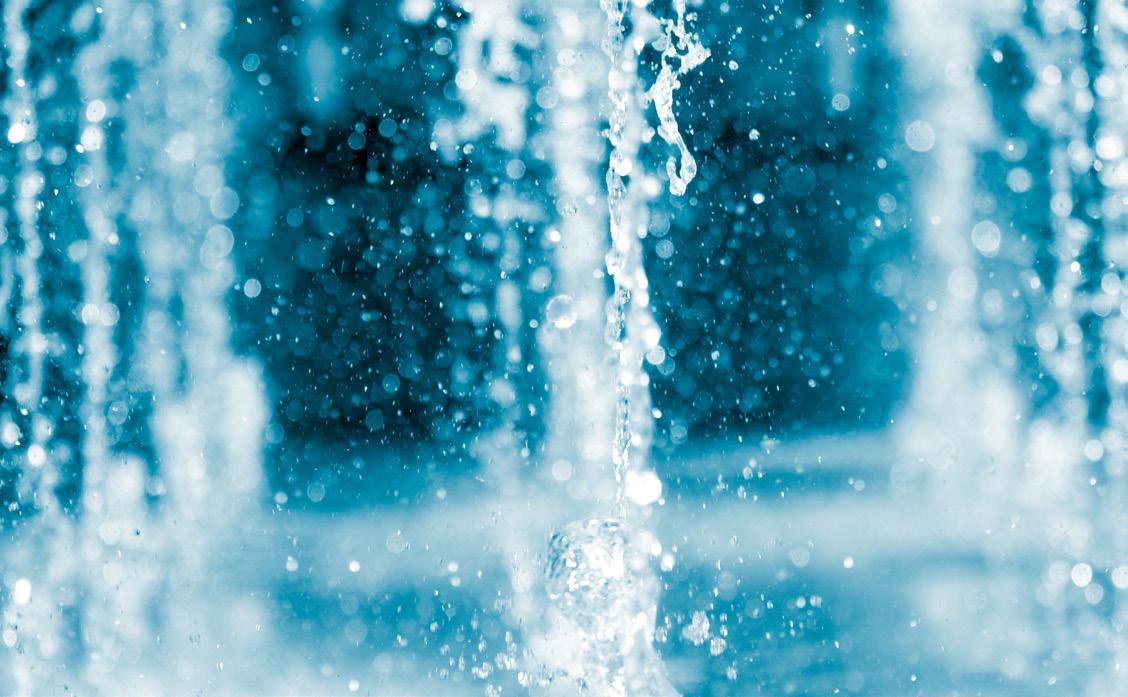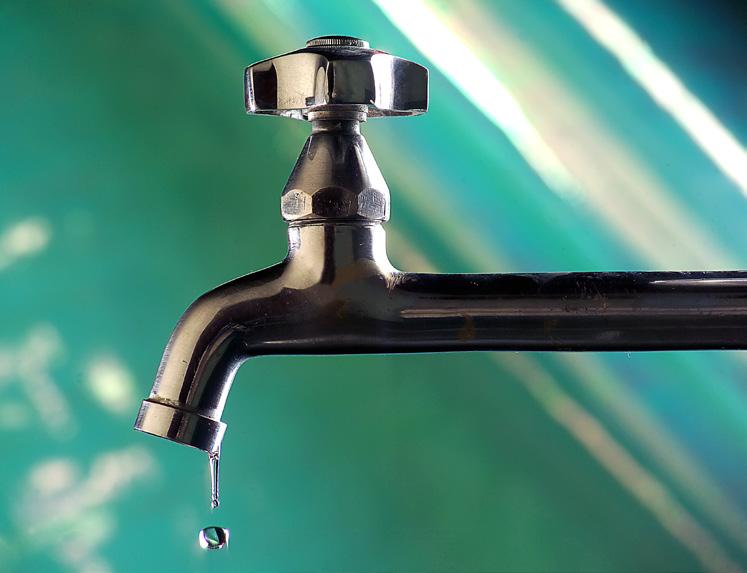
5 minute read
Reducing water use in the cleaning industry
The sector of cleaning is inextricably linked to water, the most basic component of hygiene and sanitation. Smart technology, innovative products, and advanced water-saving strategies can be implemented to conserve this precious resource. The impact of climate change is making an effective response to water scarcity essential. According to the United Nations, water scarcity affects more than 40% of the world’s population. And if the current trend continues at this alarming rate water demand will exceed supply by 40% in 2030. Clean water together with sanitation is the 6th of the UN’s sustainable development goals. Professional cleaning often includes a great deal of water use, an increasingly valuable global resource. With chemical cleaning products alone relying on large amounts of water, businesses are having to constantly rethink their priorities and pro - cesses. It’s estimated that commercial laundry washing machines use an average of 157,931 liters of water and up to 910 kWh of electricity per year. Across all sectors, including the commercial cleaning sector, companies are responding to this water scarcity crisis by embracing innovative strategies to conserve water. These include programmes to reduce water intake, use efficient water-saving equipment, reuse and recycle water, and manage wastewater treatment systems. Smart solutions for reducing water consumption in the cleaning industry is a document by Interclean , the platform for professionals in the world of cleaning and hygiene, which presents to the sector the number of innovative new products, devices, and processes that can be used by both individuals and businesses to guarantee high standards of cleanliness and hygiene, as well as maintain the controlled and efficient consumption of water. It must also be added that being sustainable and saving water not only reduces our impact on the environment, it often lowers costs and can increase profits. Commercial cleaning is experiencing a new wave in sustainability practices, motivated by a more ethically and ecologically aware generation of customers and their increasing demand for greater social responsibility, a versatile range of eco-friendly products, and a commitment to sustainability. This means that, if cleaning businesses are to be successful and remain profitable, they’re not only going to have to deliver consistency and quality, they are going to have to meet these new “green” expectations from the market, by embracing this new wave of sustainable cleaning solutions.
Rethink Cleaning Practices
Whereas in the past cleaning sched- ules were based on entrenched habits rather than a more flexible, intuitive, and accurate evaluation of what degree of cleaning (deep/ medium/ light) is necessary and how often, the recent advances in smart technology allow for far more efficient monitoring of cleanliness. This responsive data-led approach means businesses no longer have to rely on time-consuming manual floor cleaning processes for example. This new approach to harnessing the potential of machines with advanced technological capabilities not only improves productivity but also reduces environmental impact. For example, automatic floor scrubbers can clean much larger spaces far quicker and more efficiently due to their increased size and capacity. This will not only save time and energy, but automatic floor scrubbers also require less water and chemicals. Moreover, correct operation by trained operations staff along with adequate scheduled preventative maintenance, will ensure equipment continues to perform at peak condition while avoiding leaks, spills, streaking and other unnecessary forms of water seepage or discharge, in addition to minimizing the potential for emergency breakdowns.
The right equipment is key Choosing equipment to improve water conservation is one way to manage water use, and it can provide further benefits as well. An efficient auto scrubber that utilizes less water to perform routine cleaning can also run longer without stopping to dump and refill its tanks, providing a boost to productivity while conserving water.
Some key features to consider when selecting cleaning equipment are:
• pre-programmed functions for more even dosing of water and detergent solution to optimize consumption and reduce unnecessary waste;
• integrated or onboard water recycling mechanisms that decrease water usage while enabling the machine to work up to 50% longer;
• “Solution Saver” technology that allows independent dosing of water and cleaning detergents, to reduce overall consumption.
Robotics, AI and Internet of Things
The new technology in the field of cleaning can help cleaning businesses offer their clients and customers these meticulous results, with the added benefit of helping them become part of the global water-saving movement. For cleaning companies looking to lower costs and increase efficiency, the application of AI could be a great option. With the advent of AI tools, cleaning businesses software can provide various cleaning processes with minimal human input, meaning less chance of error and maximum efficiency. Many of these applications can also result in significant water saving, due to their increased efficiency.
The Internet of Things (IoT) can also allow for autonomous monitoring of spaces that need periodic cleaning. By tracking chemicals, such as dust in HVAC systems and clarity levels in water, cleaning businesses can keep one step ahead and cleaning schedules can be created in accordance with data gathered by smart sensors. For instance, the use of Internet of Things obstacles along the way. Cleaners can be redeployed to perform other cleaning tasks and re-trained to perform higher-skilled tasks, while the robots tackle the large-scale routine cleaning tasks that typically require many hours of manual labour.
(IoT) sensors can help track water quality, from treatment works right through to pipes. They can also monitor plant operational performance, checking the ratio of incoming water versus finished product liquid. The use of the right robotic cleaning machines can not only reduce water and chemical waste, but also increase productivity through the strategic planning of cleaning routes in advance. These cleaning robots can also be programmed to travel along the planned route, sensing and reacting to
There are also on the market smart device applications which can help staff at cleaning service companies improve their on-site reporting. Besides reducing errors in reporting, these applications also ensure that your cleaning operations are more efficient and economical. Employees can report their work commencement and completion times. Progress on tasks can also be tracked by supervisors. These checks will help improve the performance of your cleaning service business. This has a direct correlation with the amount of water and other resources used: a more streamlined cleaning routine equates to less water wastage.
Water recycling
Water recycling involves converting wastewater into water to be used for alternative applications. Connected technology is also being deployed on wastewater treatment. Optimizing plant operations can help reduce costs (including the use of energy and chemicals in cleaning water), which can help expand capacity without requiring a corresponding increase in investment – all while maintaining discharged water quality to meet compliance requirements. An example of where this type of water recycling innovation is utilized is in some floor scrubbing machines which feature onboard recycling systems. These “new age” floor cleaners consume less water and detergent for every clean.

Eliminate dangerous chemicals
One of the many ways in which aspiring green commercial cleaning companies can change their potentially harmful habits is to reduce or eliminate dangerous chemicals. Many commercial cleaning solvents are largely derived from petroleum. The disposal of these volatile organic compounds, or VOCs, can be very damaging to both our environment and our health. They also pollute the groundwater, deplete the ozone, and can cause lasting health problems. By switching to products that use eco-friendly ingredients, cleaning businesses can make significant improvements to the well-being of the environment by eliminating the transfer of harmful chemicals into the wastewater system, as well as safeguarding the health of their workforce, and their end-user clients. Many of these innovations are affordable substitutes and can be gradually introduced to replace their less sustainable counterparts, allowing cleaning companies to make the transition towards more sustainable practices at their own pace, and within their own budgetary constraints.
(Source: Interclean, Smart solutions to reduce water consumption in the cleaning industry)










